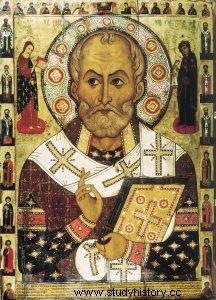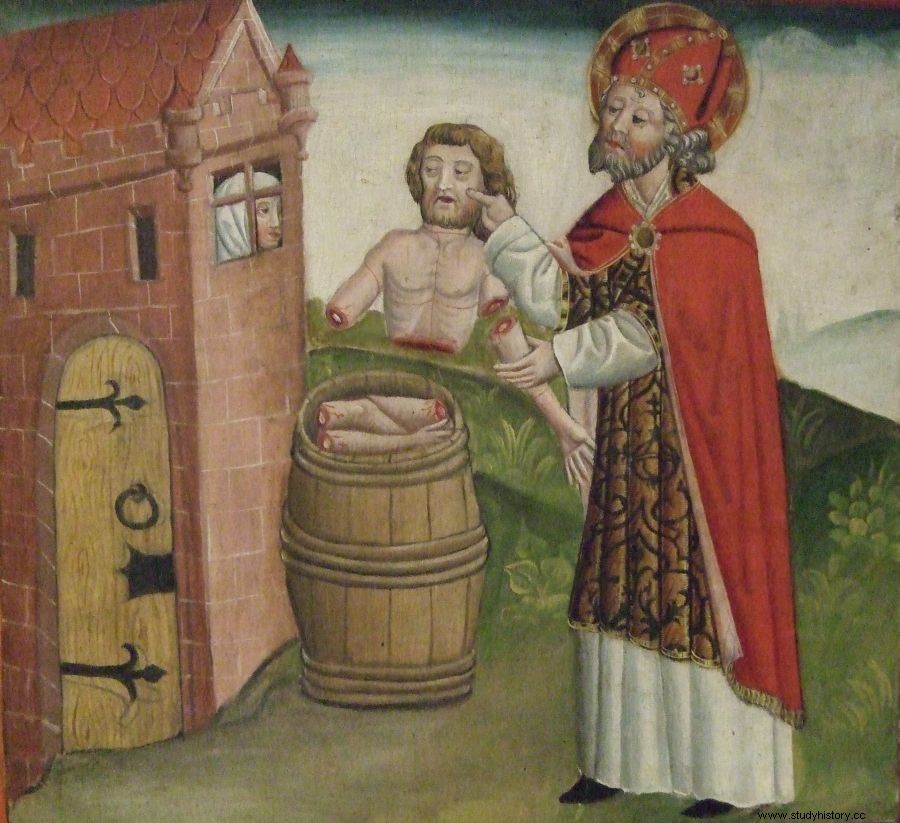Many children associate December 6th with the custom of leaving their polished boots outside the door the night before, which are then filled with gifts such as chocolate, gingerbread and nuts by St. Nicholas that night. However, St. Nicholas is much more than just a bringer of gifts and has become famous for his heroic deeds.
Who was Saint Nicholas?

Saint Nicholas has evolved over the centuries into the mythical figure we know today. Nevertheless, this custom is based on a historical person. His name of Greek origin Nikólaos means nothing less than "victory of the people". To this day, Saint Nicholas is one of the most revered figures in history. He lived in the early 4th century and was known for his kindness and helpfulness.
In fact, there is very little evidence of his life and work. Nicholas was born between 270 and 286 AD in Patara, in what is now Turkey. It is said that he was ordained a priest by his uncle at the age of 19, but this cannot be proven. During the persecution of Christians under the Roman Emperor Diocletian, Nicholas is said to have been taken prisoner and tortured. Shortly after his release he was appointed Bishop of Myra. He is said to have performed some miracles. It is said that he calmed a storm and brought several dead people back to life. Nicholas died on December 6 between AD 345 and 350
Only about 200 years later did the cult of the holy figure of Saint Nicholas begin. From Greece to the Eastern European countries and from the 10th century also in the western world. However, he became most popular in Russia:there, people not only worshiped him as the patron saint of individual professional groups, he even became the patron saint of the country.
Blessing or curse?
Most of the children look forward to his arrival and with it his praise and gifts. Poems are eagerly learned and boots are cleaned in the evening. This is one side.
Especially in earlier times, it happened that children were afraid of him, because in the vernacular Nicholas also had his downsides. If a child wasn't good, it didn't get presents, but a rod. Parents threatened their children that Nicholas would bring his companion, Knecht Ruprecht, with him. He knew about every child, especially if they were good or naughty.
Today this picture has changed in many regions:Nicholas, Santa Claus and Knecht Ruprecht are now more or less one person. A bearded elderly man with a burlap sack full of gifts.
Servant Ruprecht - gentle helper or evil opponent
Knecht Ruprecht is Nicholas's assistant. It is known by different names depending on the region. In Switzerland he is known as Schmutzli, in Luxembourg as Housecker. He is up to mischief in Austria and Bavaria as "Krampus", whereas in the Netherlands he is known as "Zwarte Piet", a kind of tamed devil. Not only does he have many names, there are also different depictions of Knecht Ruprecht. He usually wears a dark robe and a long beard. He carries with him a rod or stick and a basket filled with goodies. Darker depictions show him with fur and sometimes even with horns.
The figure of Knecht Ruprechts has been documented in customs since the 16th century. In early sources, he embodies evil and is portrayed as a kind of evil antagonist to Nicholas. His role is to whip children who have been naughty, encouraging them to be more diligent and behave well. The “rough Precht”, a ghost figure who devoured the souls of bad children, might have acted as a possible role model. Such frightening figures had their heyday in the 17th century, when attempts were being made in the course of educational measures to make children docile through fear. Over time, however, the figure of the evil, punishing Ruprecht changed in most regions into a benevolent bringer of gifts and helper of St. Nicholas.
Nicholas as a gift bringer - The Bishop's Game
The custom of a person disguising himself as St. Nicholas and giving presents to the good children probably comes from a medieval custom, the bishop's game. A child was appointed bishop for one day in monastery and monastery schools. Dressed in appropriate robes, they rewarded or punished the other children for their behavior. The game originally took place on December 28th, the Feast of the Holy Innocents. This custom was later put on St. Nicholas Day to honor St. Nicholas.
The fact that Santa Claus brings gifts goes back to a legend.
Nicholas and the penniless merchant
Even before Nicholas became bishop, he inherited quite a considerable fortune. At that time, a poor merchant lived near him who could not afford his daughters' dowries. In order to marry them anyway, he had the perfidious idea of raising the money through his daughters' prostitution. Nikolaus overheard this and one night secretly threw a nugget of gold down the merchant's chimney. He could now marry his eldest daughter with the gold. Nikolaus repeated this gesture twice more so that the other two daughters could also be married. The merchant caught the secret patron with the last nugget of gold. Nicholas then asked him to keep quiet, but the merchant told everyone who wanted to hear.

This legend is said to have caused adults to do the same as St. Nicholas; they threw gifts into a room where the children were staying. However, since older children - due to their size - had an advantage in catching the presents, the custom developed of putting the presents in a container overnight.
Of boats and boots
Since at least the 15th century, children have been making small boats out of paper or other materials in which Saint Nicholas would place presents. But why ships? According to legend, the bishop was a patron saint of seafarers and saved sailors in distress from their deaths. It is not without reason that churches near the coast like to bear the name Nikolai. The ship soon became an attribute of the sacred in art and became a symbol of St. Nicholas Day in some regions.

The custom of stuffing socks probably arose from the legend of the merchant (see blue box above). It is said that gold nuggets thrown down the chimney got caught in a sock. The existing bowls and bowls were also used in everyday life, so it made sense to use the children's shoes or boots.
Since the Reformation in the 16th century, in the areas of the Counter-Reformation, the tradition of pickling has been transformed into a retreat. An adult disguised as Santa Claus came into the living room and checked whether the children had fulfilled their duties. "Good" children were given presents, "negligent" children were admonished. Critics dub this form of education “fear mongering”. Although the custom of stopping off in some regions still exists today, it usually no longer has an evaluating, judging character.
Other Legends
There are a number of legends attributed to Saint Nicholas, but it is believed that in some cases two historical figures merge into one:the aforementioned Nicholas of Myra and his namesake, the Bishop of Pinara.
A very impressive legend tells of a revival. Out of greed, three scholars were killed by an innkeeper, dismembered and put in brine. When Nicholas heard this from an angel, he went to the innkeeper and confronted him. He then found the Salt Cellar, reassembled the Scholars, and brought them back to life. Resurrections were not uncommon for Nicholas.

Another legend says that Nicholas was already very pious as an infant. For example, on the weekly fast days (Wednesdays and Fridays) he took his mother's breast only once a day.
Last but not least, a few more legends in fast forward:Nicholas saved people from famine, brought a kidnapped child back home via whirlwind, saved innocent people from execution and fought the ancient goddess Diana.
